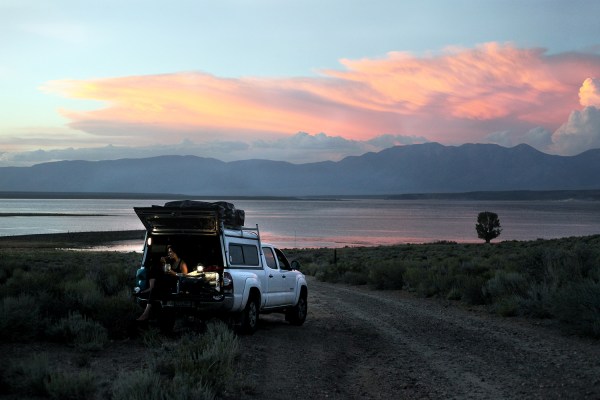Whether your favorite camp spot is next to a river, deep in the forest, off a mountain road, or tucked away among a sea of sagebrush, these escapes are places we cherish.
And while there’s no doubt we love and revere these patches of nature, we are constantly reminded by conspicuous, often weathered, signage to “Leave No Trace.” And trust me when I say I don’t doubt that you take these words to heart. But what I can offer are a few tricks and tips that might help you leave less of a trace and make that camping trip a little more epic.

A summer campout in the Eastern Sierra can’t be beat, especially with spectacular sunsets. This was our second night on a month-long road trip from San Francisco to Alberta. We saw many sights and camped in some incredible places, but the shores of Lake Crowley had to have been one of our favorite campsites. Here’s Meg Haywood Sullivan recharging with a home-cooked meal and a view to feast on.
1. “It’s biodegradable—just throw it in the bushes!”
This isn’t exactly as cut and dried as you might think. While food scraps are biodegradable, they may not break down easily. For example, you might be surprised to learn that an aluminum soda can will, in most circumstances, biodegrade more quickly than an orange peel. Why? Because certain environmental conditions are required to initiate the decomposition process, such as moisture and heat.
Think of your backyard compost pile. Add organic material, dried carbon (e.g., grass clippings) and a little water, and voilà, you’ve initiated the biodegradation process. Furthermore, tossing organic material into the bushes with the “don’t worry, it’ll biodegrade” attitude shouldn’t be the way you think of nature. Instead, leave no trace and pack it out! You wouldn’t want to show up at your favorite campsite and find a trail of orange peels leading to your favorite lookout or fishing hole, would you?
2. Feeding wildlife.
One day you may come across an overly friendly squirrel, curious bear, or mischievous raven, and consider tossing it a scrap of food. Don’t. The best explanation I and other scientists may offer is this: All it takes is one scrap of people food to turn a wild, self-sufficient animal into one that is permanently and often irreversibly hooked on human garbage.
Not only can this shift in behavior lead to the animal’s death—whether it becomes a danger to the public and is shot or is run over by a car—but that animal, if it survives to reproduce, will pass that behavior on to its offspring, which can then trigger a chain reaction through a population just as it has among black bears at Yosemite and Lake Tahoe. Instead, bring some binoculars and watch wild animals acting wild, instead of bringing food scraps to feed and watch sick animals.
3. Keep the music down.
This might seem like an over-reaching comment, but if leaving no trace is your goal, than keep reading. While a boom box at the campfire sounds like a good idea, the excessive noise will scare away any wildlife that may offer you a fleeting glimpse, like a curious fox, barred owl or elusive night heron. Furthermore, that music may also negatively affect all of the nocturnal animals trying to hunt, forage or communicate with one another in your neck of the woods.
Just as we use our eyes to see the world, most nocturnal animals use sound to see the world. And while that newest playlist might be music to your ears, it’s flooding the natural soundscape (think landscape, but with sound) with a cacophony of noise that will make it harder for the nocturnal to go about their nightly business.
4. Campfires—are they necessary?
I admit there’s something magical about a campfire. Maybe it’s the warmth, the flicker of light, or the sound of crackling wood. Whatever it is, most circles consider a campfire a must for any camping trip. I ask you: Consider where that wood is coming from, where that smoke (filled with greenhouse gasses) is going, and whether a fire is legal or safe in your camping location.
Here are some facts: Campfires are the leading cause of wildfires in North America; they contribute to global warming; and they’re often fueled by hardwoods like oaks, which are widely regarded as keystone species, meaning they represent a vital pillar of the ecosystem just as sharks or wolves do. Furthermore, rangeland managers and ranchers have long been under the impression that removing oak trees (often for firewood) increases long-term rangeland production (i.e., more grass for more cattle), but that simply is not true. Feel free to research this on your own if interested.
5. The power of social media.
In this day and age everything we do is open game for social media, whether it’s what we cooked for dinner, our campsite, or latest addition to our adventure mobile. One thing that I would urge you to consider is the effect you have on your social media community. Are you leading by example? All it takes is one photo of a tent right on the shore of a lake to inspire countless other campers to camp in a location that’s illegal and without the environment in mind (a 150-foot buffer should always be honored when camping near bodies of water). Even if your tent was just pitched and curated for the photo, it still comes across as your camp spot. Keep this in mind, because it might help protect your beloved campsite from abuse or misuse, and help keep your sanctuary all the more pristine for years to come. After all, if you don’t protect it, who will?
